
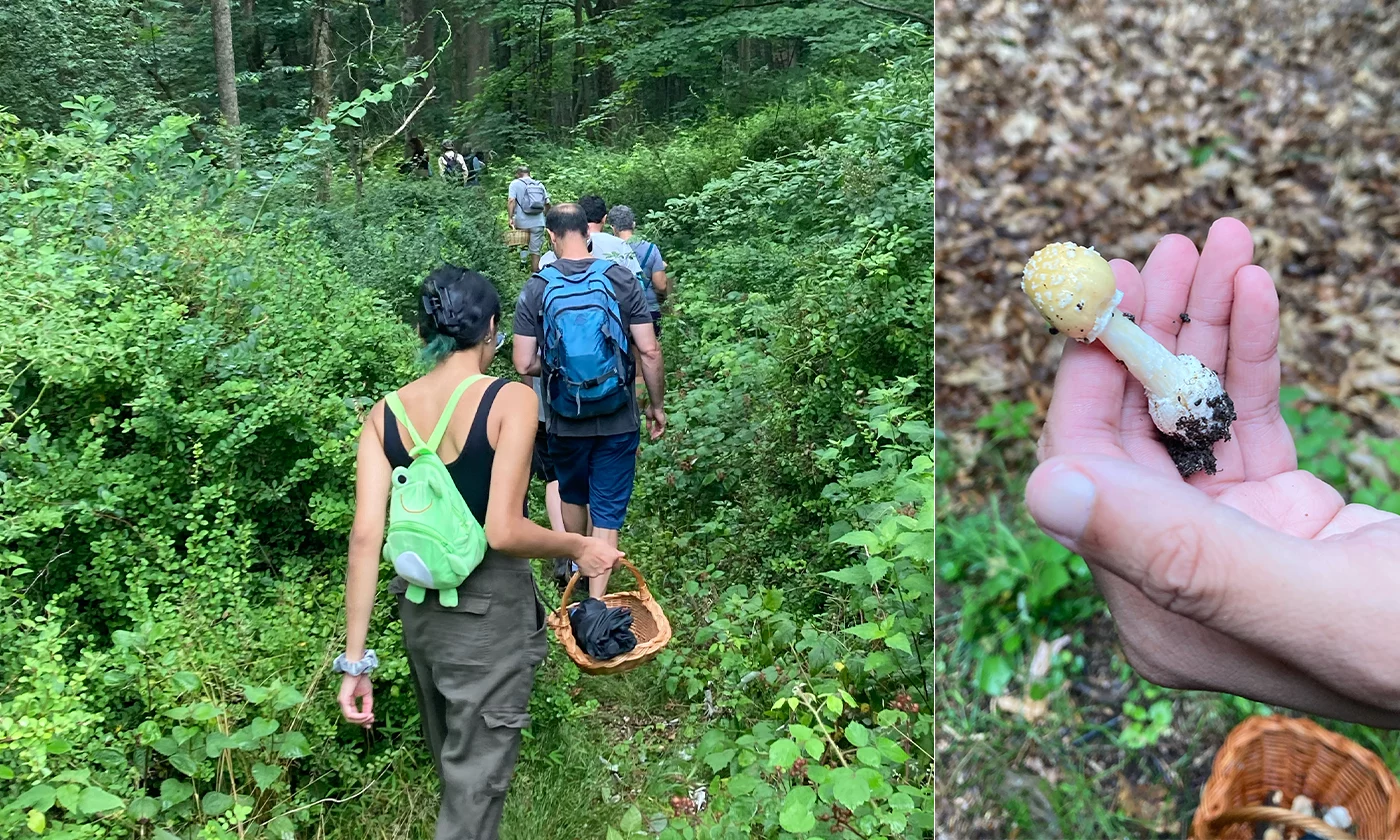
A group goes foraging for fungi in the New York Botanical Gardens. PHOTO BY REINA GATTUSO
By Reina Gattuso|YES! Magazine
This story was produced with the support of CivicStory and the New Jersey Sustainability Reporting project.
On a sunny, early-July morning, a small crowd gathered at the edge of the New York Botanical Garden’s reflecting pool. The previous night’s heavy rain rose as mist from the wet earth, lingering with the traces of smoke from Canadian wildfires. Mushrooms, too, had risen.
The group followed a path into the Botanical Garden’s remaining patch of old-growth forest, stewarded originally by the Lenape people. Mushrooms peeked from the leaf rot, latticed the downed logs, and were cradled in the nooks of trees. Fungi grew, too, from the wooden fence meant to keep people on the path, blurring the boundaries between the forest and its visitors.
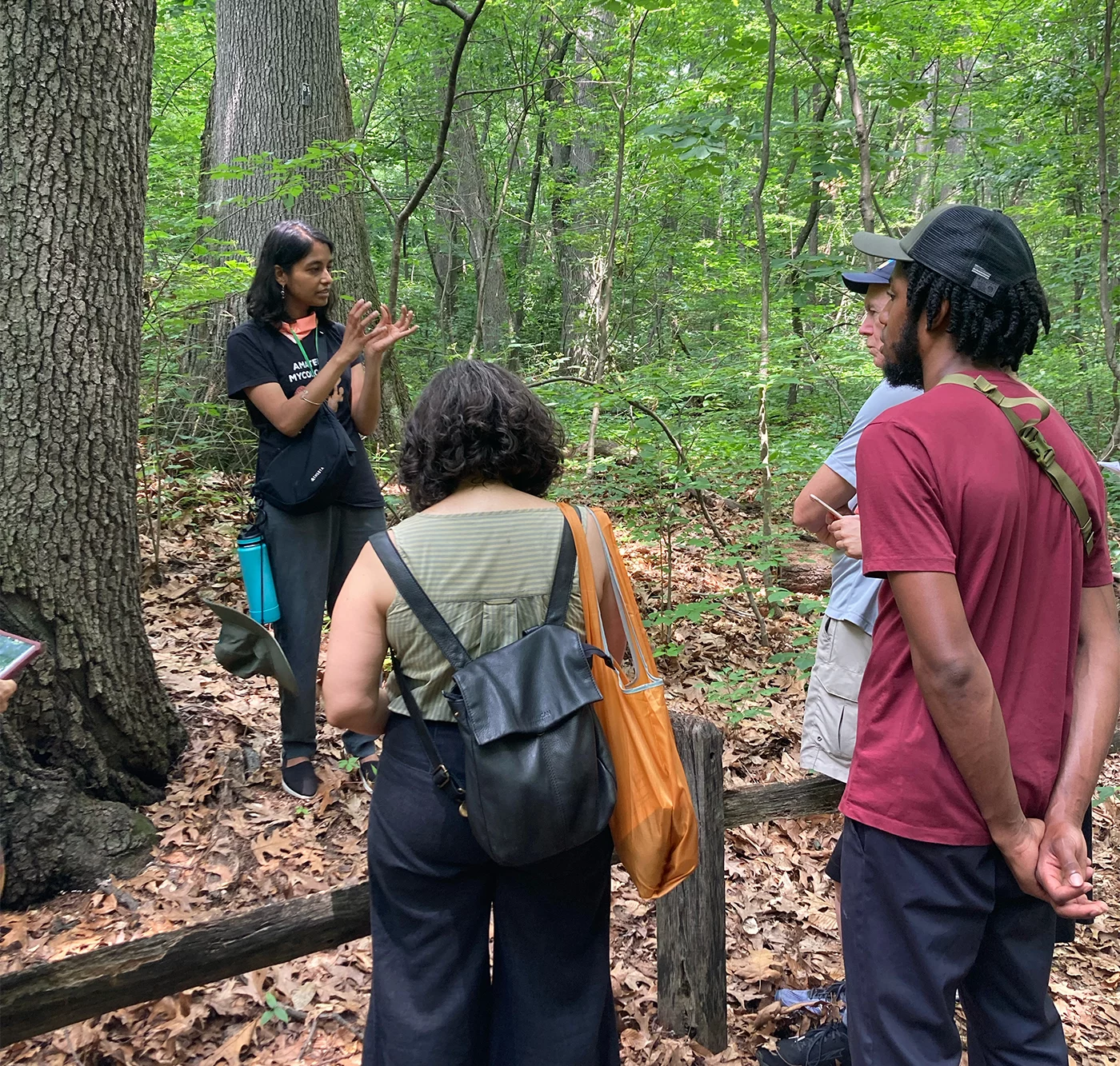
“Today, we’re going to move as a community,” said Sneha Ganguly, an artist and mycophile (lover of fungi) in her early 30s. In her “alter ego” as Kali Mushrooms, Ganguly leads online courses, fungi workshops, and forays—group outings wherein mycophiles observe, identify, and sometimes collect mushrooms. Ganguly also founded New York City’s first Fungus Fest in 2022, and continues to organize the festival on behalf of the New York Mycological Society (NYMS).
Many of the 15 or so people in attendance at the festival—ranging from 5-year-olds to retirees—were from the surrounding neighborhoods of the Bronx, and many were members of the NYMS. They are also part of a broader trend of increased public interest in all things mushroom.
Fungi perform key functions for ecosystems and support collective thriving. Yet compared to their counterparts in the animal and plant kingdoms, they remain poorly understood within mainstream United States society. As a result of institutional disinterest, they enjoy very few global conservation protections.
In recent years, however, a coalition of mycology enthusiasts, many from amateur mycological associations across the United States, is changing this. These mycophiles are engaging in community science to identify, document, and protect fungal species, many of which are rare or threatened.
Mycophiles of color, specifically, are challenging the colonial legacies within the natural sciences. They’re using mycology to reclaim caring relationships with nonhuman life. In doing so, they are creating more collective ways for communities to learn about and steward local biodiversity.
Budding Interest
Western scientists have historically labeled fungi “lower plants.” In fact, they were only officially designated a distinct phylogenetic kingdom in 1969, according to Gabriela D’Elia, director of the Fungal Diversity Survey, or FUNDIS, a U.S. nonprofit entirely dedicated to fungi conservation.
As a result of this historical neglect, scientists have cataloged only between 3% and 8% of the world’s fungal species. While scientists know that many fungi species are rapidly becoming extinct, the lack of basic research makes it difficult to estimate how many, and how quickly. According to D’Elia, it’s likely that “at this pace, especially in North America, we’re losing fungal species faster than we can document them.” Communities worldwide also have their own names and relationships with fungi—knowledge that scientific institutions often commodify, exclude, or erase.
Fungi are difficult to track and protect under conventional conservation frameworks. These frameworks most lend themselves to the study of individual organisms that can be more easily observed and counted, such as polar bears, explains Patricia Kaishian, curator of mycology at the New York State Museum.
In contrast, much of the fungal organism is invisible to the human eye. Mushrooms, for example, are actually the reproductive parts of a larger organism, whose weblike mycelia burrow into their substrate—a tree, say, or the soil—to feed. It is often difficult to tell where an individual fungus’s mycelia ends and another’s begins.
Similarly, fungi often form symbiotic relationships with other organisms—including human beings. Around 90% of vascular plants have a relationship with a mycorrhizal fungi. Fungal mycelia, intertwined with plant roots, form vast mycorrhizal networks under the forest floor—“the nervous system of the earth,” as Ganguly metaphorically describes it.
Fungi are diverse, from the dermatophytes that grow on our feet to the portobellos on our dinner plates. They often feed on dead organisms, recycling the nutrients so other beings can use them. “Their job is to destroy everything and bring it to simple molecules,” says Maria Shumskaya, an associate professor of biology who studies fungi at New Jersey’s Kean University.
Over the past few years, scientific institutions have begun to devote increased research to fungi’s many incredible applications: their ability to treat illness, create sustainable fabrics, and remediate soil by feeding on toxic waste. Yet there are still relatively few professional mycologists—according to FUNDIS there are 1,000 mycologists in the U.S. compared to 17,000 zoologists and wildlife biologists. The funding to support the study of fungal biodiversity is similarly limited.
Local mycological associations help fill in that gap. Nonprofessionals are increasingly interested in mycology, as reflected in the growing membership of the New Jersey Mycological Association (NJMA), which reached 1,000 members by the end of 2022 (more than double pre-pandemic numbers). Many people joined mycological associations during the early part of the COVID-19 pandemic; others are motivated to take action by their increasing climate anxiety.
At the Botanical Garden foray, several participants spoke of their desire to reclaim a connection with the land. Nigel Smith, a landscape gardener from the Bronx, became interested in mycology a few years ago. “Being in the modern day, it’s a lot of worry and uncertainty,” he says. “This feels like a path of our ancestors.”
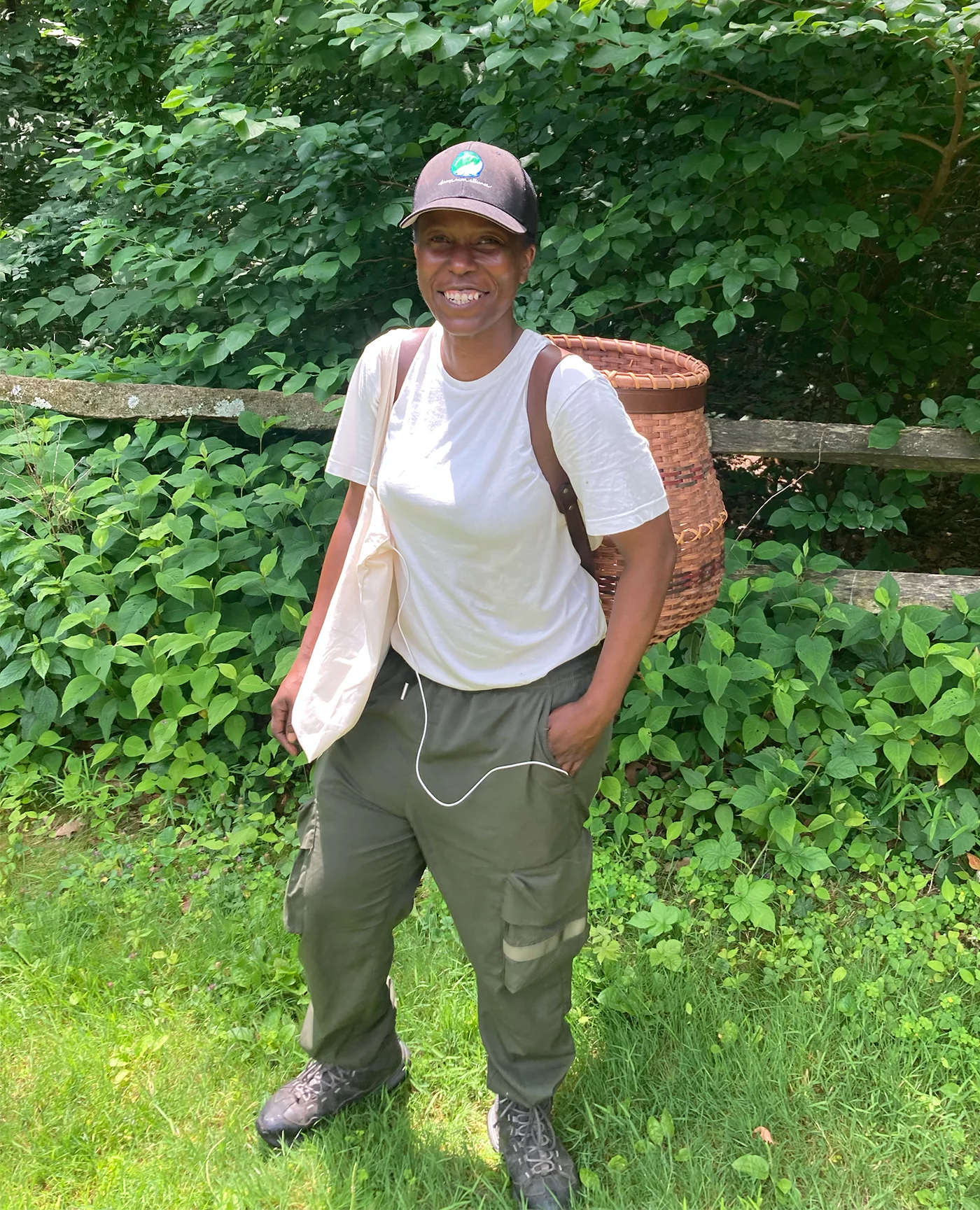
Journei Bimwala, a clinical herbalist and artist in residence at the Bronx River Alliance, came equipped with a large foraging basket. “I want for us to be able to gain our knowledge and access back,” she says. She is the community outreach coordinator with the New York Mycological Society and educates about foraging at the Bronx River Foodway, the only legal public foraging space in New York City. “I’m all about being out, and introducing people, and having them reconnect,” she says.
Budding mycophiles join peer-to-peer networks whose participatory approach to science takes a cue from their fungal neighbors. “It’s definitely a mycelial community network,” says Katie Crawford, a New Jersey Mycological Association member who is helping to plan the New Jersey Fungus Fest.
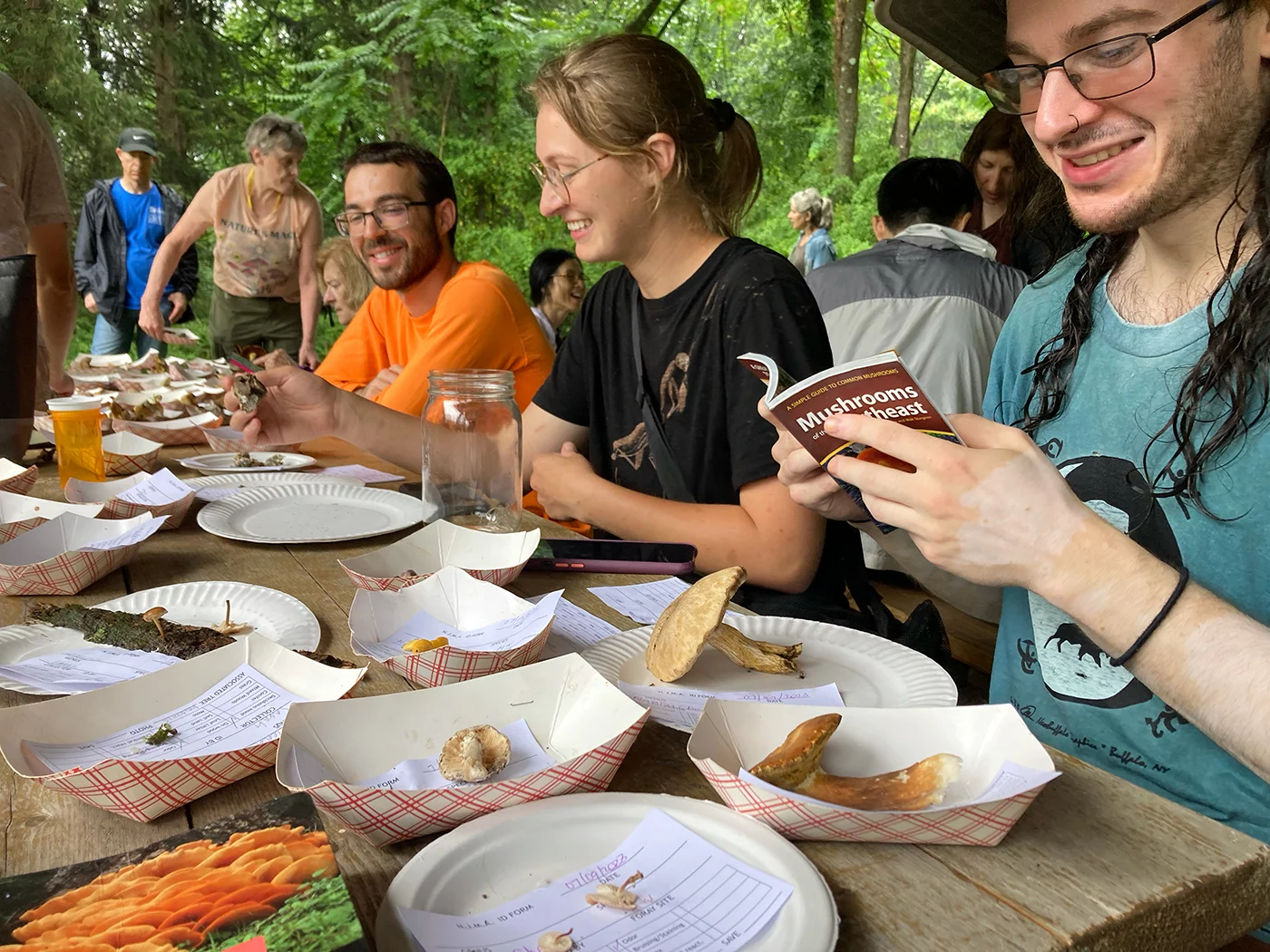
Community Science
A week after Ganguly led the foray through the New York Botanical Garden, a group of about 35 people from the New Jersey Mycological Association gathered in the parking lot of a park in central New Jersey. Then they dispersed into the trees.
Noticing mushrooms is an art. “You have to have an eye for it,” says Igor Safonov, the association’s treasurer and membership coordinator.
One moment, participants were walking along, chatting. The next, one of them shot off the path quick as a deer, squatting to inspect a saucer-sized brown mushroom with a floppy cap and gauzy, labial gills. “It’s a platterful,” they announced. The platterful felt smooth and meaty to the touch, like sweat-cooled human skin, and smelled of the soil it came from. As the participants walked, they stopped frequently to cut and tuck mushrooms into the natural-fiber baskets hanging from their arms.
Participants emerged from the forest in small groups and gathered intently under a covered pavilion to begin identification. They deposited the mushrooms they’d picked into red-and-white-checkered food trays on the picnic tables.
Mushrooms can be identified by a range of qualities: their location, size, color, odor, and taste. (According to Kaishian, mycologists consider it safe to taste and spit out, but not swallow, a small amount of any mushroom when attempting to distinguish between two closely related species. However, many mushrooms are seriously sickening and even deadly to swallow. When starting out, it is best to do this only with someone who is highly experienced. Don’t use this article alone as a guide.) Some mushroom-hunters huddled over field guides, bending their heads together to inspect the stems and gills illustrated across the pages. Others snapped pictures to upload onto the iNaturalist Fungal Diversity Database, Mushroom Observer, or even Facebook, where the broader community can help with identification.
The most valuable source of mycological knowledge in any region is mycophiles themselves. Some have been coming to the same spots for decades. This kind of specialized, local knowledge isn’t just useful—it’s necessary. Especially considering that some mushrooms are poisonous, Ganguly says, mycophiles must show reverence for the fungus and respect for collective wisdom.
Participants record information on small slips about each mushroom they collect. Club officers keep the slips and toss most of the mushrooms back into the forest. A designated member then logs the data on a spreadsheet. Occasionally, they dry a particularly rare, new, or interesting mushroom to deposit it in the club’s partner fungarium at Rutgers University.
Sometimes, club members send samples for genetic sequencing. PCR (polymerase chain reaction) DNA testing has recently become much cheaper and more accessible, leading to a surge in new mushroom identifications. The neighboring New York Mycological Society lends its members compound microscopes and PCR kits to sequence the DNA of the mushrooms they collect.
Data from mycological associations across the United States enables collaborations between community scientists and their counterparts in the academy. Shumskaya, the Kean University scientist, recently published a paper using data from the New Jersey Mycological Association. From 2007 to 2019, Shumskaya reported, association participants identified 1,248 distinct fungi species. The data included 691 species that hadn’t previously been included in the Global Biodiversity Information Facility for New Jersey, and four unique to the facility’s global database.
These long-term efforts reveal shifts in local fungal biodiversity. Since 2009, New Jersey Mycological Association member Nina Burghardt has organized a monthly fungal foray to the Franklin Parker Preserve in Chatsworth, New Jersey.
“A lot of the fungi that [were] typically in Florida and Texas are making their way up here,” says Burghardt. Mycologists argue that climate change may be causing a shift in fungal distributions.
Fungi are often neglected in environmental policy, but they are a source of valuable information. Fungal diversity data can help communities advocate for their local ecosystems, based on the premise that when fungi suffer, ecosystems suffer—and when fungi thrive, ecosystems thrive. “There is a symbiotic relationship, that reciprocity,” Bimwala says.
Colonial Legacies—and Collective Reclamations
Institutional neglect of fungi is part of the larger story of environmental degradation caused by the linked systems of capitalism and Euro-American colonialism. Collections from European colonial expeditions formed the core of many early herbaria and fungaria. While the archives mostly name European collectors, Ganguly points out, unnamed local people did much of the actual collecting based on their deep and ancestral knowledge of a given place. Yet colonial authorities frequently erased those contributions, and often excluded the people they colonized from accessing scientific and educational institutions, Kaishian says.
This colonial legacy is evident in the continued exclusion of people of color from scientific fields, and the ongoing theft and commodification of Indigenous knowledge.
Amateur mycological associations are often more democratic than formal scientific institutions. “Being a citizen scientist, there’s really a ton of entry points,” says Sydney Hilton, the New Jersey Mycological Association’s newsletter editor. Yet Hilton and others say that inequalities persist.
“When you do want to join, you have to face the fact that you will be the only person of color in a mostly white group,” says Ganguly of many mycological societies. “That reverberates into institutional power, and economic resources, and funding.” More mycophiles of color have joined mycological societies in recent years, contributing data to surveys as community scientists. Yet the professional academics who publish papers—and who receive money and accolades—are disproportionately white.
In addition to being a member of a couple local mycology associations, Ganguly co-founded the POC Fungi Community with Mario Ceballos and a handful of other mycophiles of color interested in social-justice-centered science.
“We organized in response to not seeing representation,” says Ceballos, who also serves as co-chair of Yaquis of Southern California, and who is based in San Diego. “We responded by creating our own organization, our own community—organizing around science, mushrooms, our love for medicine, and community care.”
Community mycologists can embrace the tools of science, while criticizing the colonial legacies within scientific institutions, Kaishian says.
Indeed, there is a long history of radical groups conducting community science—most famously, the Young Lords’ Lincoln Hospital takeover and the Black Panthers’ People’s Free Medical Clinics.
The POC Fungi Community recently opened a community lab, where they’re researching fungi’s potential to clean polluted soil. Ceballos’ research focuses on the reclamation of huitlacoche, a corn fungus English speakers pejoratively dubbed “corn smut.” Many Indigenous Mexican peoples, including Ceballos’ community, consider huitlacoche a sacred and delicious staple food.
But colonial farmers considered it a scourge. The USDA has supported the development of genetically modified corn meant to resist huitlacoche growth, while many U.S. agricultural institutions still recommend farmers burn huitlacoche if they find it. Because of this policy of eradication, fresh, market-rate huitlacoche, typically imported from Mexico, can cost up to $20 a pound in the United States—many times more than what it would normally cost in Mexico. This prohibits access for many people who have an ancestral connection to the fungus. Ceballos and his collaborators want to support community members in growing and accessing huitlacoche.
Ceballos says he’s faced racist backlash from within the mycology community for his anti-racism activism. Kaishian, similarly, experienced backlash from mycophiles who consider her research on queer mycology “inappropriate.”
Yet mycophiles in these spaces also see positive changes. More people of color are joining, leading, and creating their own mycological spaces. And more people are interested in connecting mycology, queerness, and social justice.
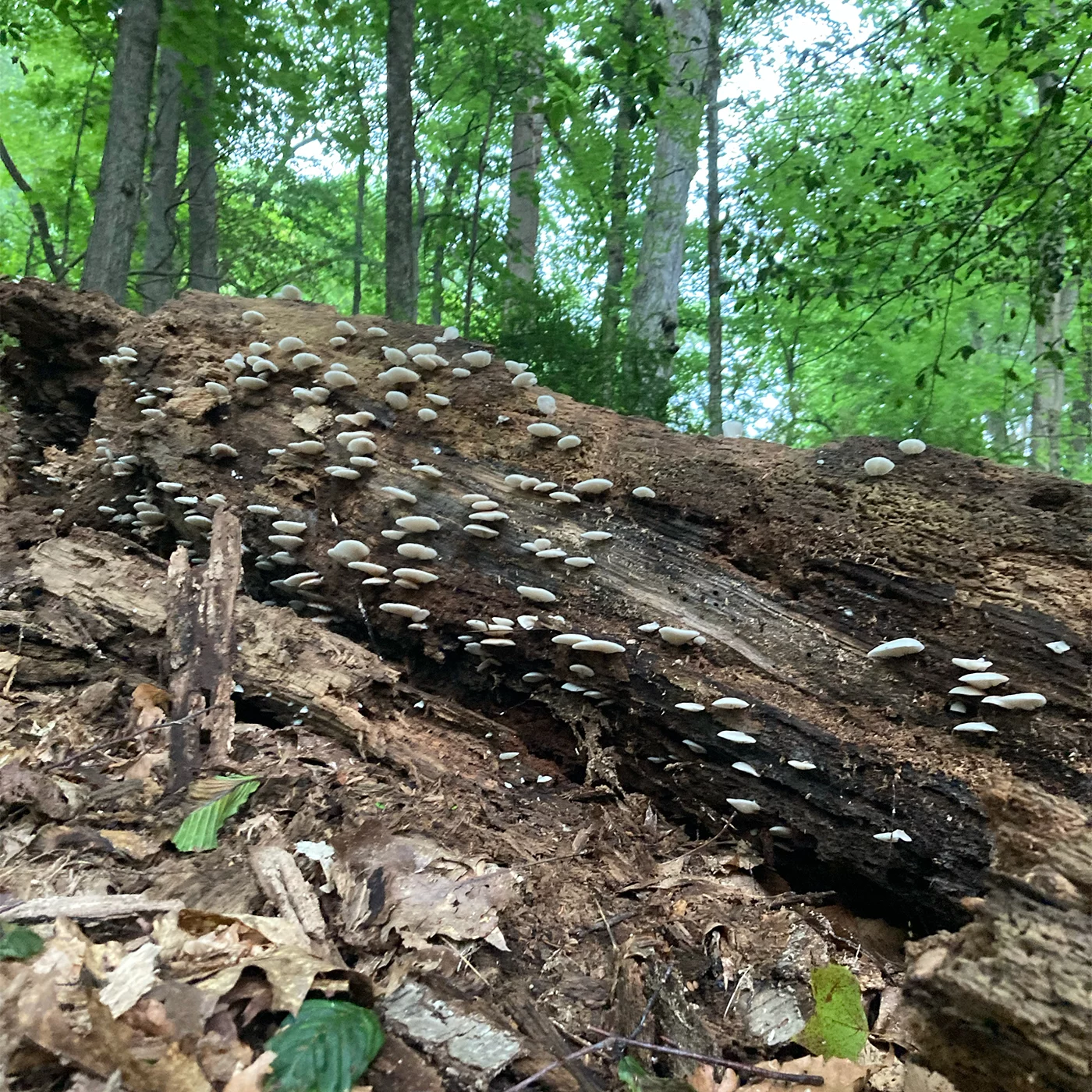
Mycelial Networks
Mycology has proven transformative for many. Among the groups featured in this piece, it has inspired people to get involved in their communities; to take a chance on their passions; and to intertwine their well-being with that of their neighbors, both human and nonhuman. D’Elia, from the Fungal Diversity Survey, describes leading a weekend-long mushroom walk that ended with some participants “sitting around the table questioning their jobs.”
Several community mycologists shared similar experiences. One bright June morning I called Katie Crawford, a member of the New Jersey Mycological Association; she was about to start her last day at Google. “Fungi was sort of my gateway to figure out, ‘How can I get more involved in my community?’” she says. Now she’s going to devote herself full-time to environmental-focused work. Similarly, Ceballos, who previously worked in health care, is now a full-time caretaker and community mycologist.
Many who grew up witnessing the effects of climate change consider ecological stewardship a matter of survival. “Now it’s less of a hobby and more of an obligation—more of a commitment, a responsibility,” says NJMA member Hilton. These mycophiles envision a massive shift in our society’s relationship with the more-than-human world—a reknitting of ourselves into webs of life and death, reciprocity and mutual obligation.
It’s a kind of reconnection that fungi are uniquely equipped to teach us. “Just like a mushroom, everything is community,” says Bimwala. She found these relationships with the plants and fungi she foraged, with other animals, and with fellow human beings. “So when we’re in community, guess what?” she says. “We share. We look out for one another.”
This story was produced with the support of CivicStory and the New Jersey Sustainability Reporting project.
This story was produced in collaboration with CivicStory as part of the New Jersey Sustainability Reporting project.
